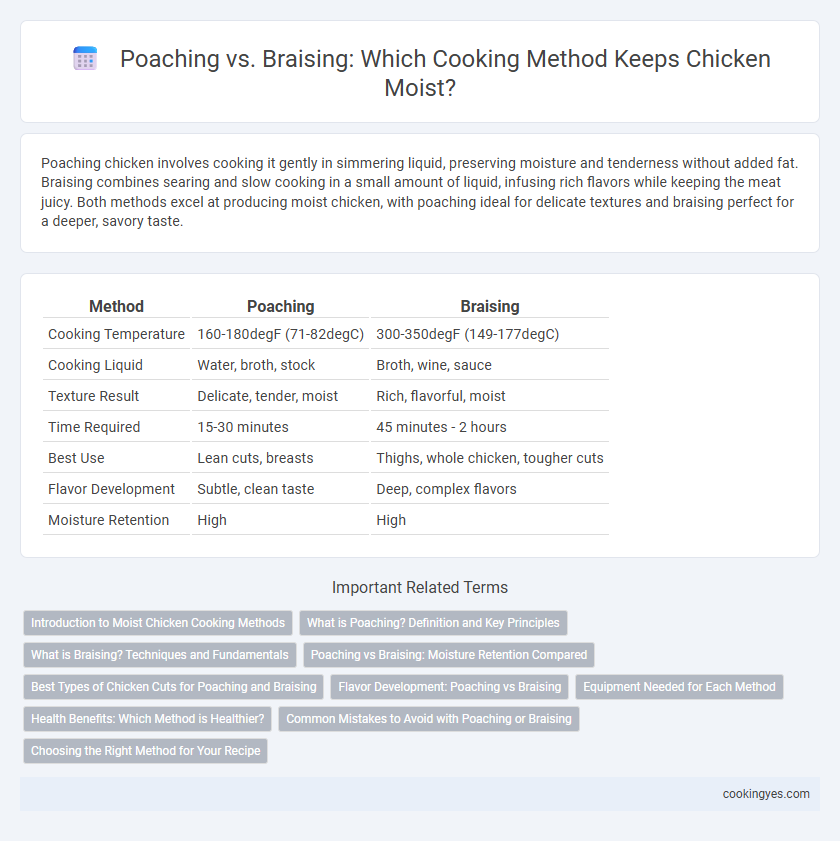Poaching chicken involves cooking it gently in simmering liquid, preserving moisture and tenderness without added fat. Braising combines searing and slow cooking in a small amount of liquid, infusing rich flavors while keeping the meat juicy. Both methods excel at producing moist chicken, with poaching ideal for delicate textures and braising perfect for a deeper, savory taste.
Table of Comparison
| Method | Poaching | Braising |
|---|---|---|
| Cooking Temperature | 160-180degF (71-82degC) | 300-350degF (149-177degC) |
| Cooking Liquid | Water, broth, stock | Broth, wine, sauce |
| Texture Result | Delicate, tender, moist | Rich, flavorful, moist |
| Time Required | 15-30 minutes | 45 minutes - 2 hours |
| Best Use | Lean cuts, breasts | Thighs, whole chicken, tougher cuts |
| Flavor Development | Subtle, clean taste | Deep, complex flavors |
| Moisture Retention | High | High |
Introduction to Moist Chicken Cooking Methods
Poaching gently cooks chicken in simmering liquid, preserving moisture and tenderness, making it ideal for delicate textures and subtle flavors. Braising combines searing with slow cooking in a small amount of liquid, infusing rich flavors while breaking down connective tissue for succulent, moist meat. Both methods excel in retaining chicken's juiciness, with poaching favoring lightness and braising emphasizing depth.
What is Poaching? Definition and Key Principles
Poaching is a moist-heat cooking technique where chicken is gently simmered in liquid at low temperatures, typically between 160degF and 180degF, preventing the meat from drying out or toughening. Key principles include maintaining a consistent low temperature, using flavorful liquids such as broth or wine, and ensuring the chicken is fully submerged to evenly cook and retain moisture. This method preserves the delicate texture and natural juices, resulting in tender, succulent chicken ideal for salads, sandwiches, or cold dishes.
What is Braising? Techniques and Fundamentals
Braising is a cooking method that involves searing chicken at a high temperature followed by slow cooking it in liquid at a low temperature, ensuring tender and moist meat. The fundamental techniques include browning the chicken to develop flavor, then cooking it partially submerged in broth, wine, or other flavorful liquids in a covered pot. This method combines dry heat and moisture to break down connective tissues, resulting in succulent, juicy chicken ideal for hearty dishes.
Poaching vs Braising: Moisture Retention Compared
Poaching chicken involves gently cooking it in simmering liquid at a low temperature, which helps retain maximum moisture by preventing the meat from drying out. Braising combines searing and slow cooking in a small amount of liquid, allowing the chicken to absorb flavors while maintaining moisture through covered cooking. Poaching generally results in more uniformly moist chicken compared to braising, which can produce richer texture but may lose some surface moisture during initial searing.
Best Types of Chicken Cuts for Poaching and Braising
Poaching works best with delicate chicken cuts such as breasts and tenderloins, which absorb liquid flavors while staying moist and tender during gentle cooking. Braising suits tougher cuts like thighs and drumsticks, where slow cooking in flavorful liquids breaks down connective tissues, yielding rich, juicy meat. Selecting the right cut optimizes moisture retention and texture, with poaching preserving the lightness of white meat and braising enhancing the succulence of dark meat.
Flavor Development: Poaching vs Braising
Poaching chicken involves cooking it gently in liquid at low temperatures, resulting in tender, moist meat with subtle flavor infusion primarily from the poaching liquid. Braising combines searing the chicken to develop a caramelized crust and slow cooking in a flavorful broth or sauce, enhancing depth and complexity through Maillard reactions and ingredient integration. The choice between poaching and braising hinges on whether delicate moisture retention or robust, rich flavor development is the priority.
Equipment Needed for Each Method
Poaching chicken requires a shallow pan or skillet with a lid and enough liquid to gently submerge the meat, often using water, broth, or wine to infuse flavor while maintaining moisture. Braising chicken demands a heavy-bottomed pot or Dutch oven with a tight-fitting lid to allow even heat distribution and slow cooking in a small amount of liquid. Both methods rely on controlled heat and sealed vessels to ensure tender, juicy results.
Health Benefits: Which Method is Healthier?
Poaching chicken involves gently cooking it in water or broth, preserving moisture without added fats, making it a low-calorie and heart-healthy method rich in protein. Braising combines slow cooking with a small amount of fat and liquid, which helps retain tenderness but may increase calorie and fat content depending on the ingredients used. For optimal health benefits, poaching reduces fat intake and maintains nutrient density, while braising offers richer flavors with moderate fat, suitable for balanced eating.
Common Mistakes to Avoid with Poaching or Braising
Overcooking chicken during poaching leads to dry, flavorless meat, so maintaining a gentle simmer below boiling is crucial. Braising chicken at too high a temperature can cause toughness, while failing to partially cover the pan results in uneven cooking and moisture loss. Avoiding these mistakes ensures tender, juicy chicken with enhanced flavor and texture.
Choosing the Right Method for Your Recipe
Poaching chicken gently cooks it in simmering liquid at a low temperature, preserving moisture and producing tender, delicate meat ideal for recipes like chicken salads or cold dishes. Braising combines searing with slow cooking in flavorful liquid, infusing the chicken with rich taste while maintaining juiciness, perfect for hearty meals such as coq au vin or chicken stew. Selecting poaching or braising depends on desired texture and flavor intensity, with poaching offering subtlety and braising delivering robust, succulent results.
Poaching vs Braising for Moist Chicken Infographic

 cookingyes.com
cookingyes.com